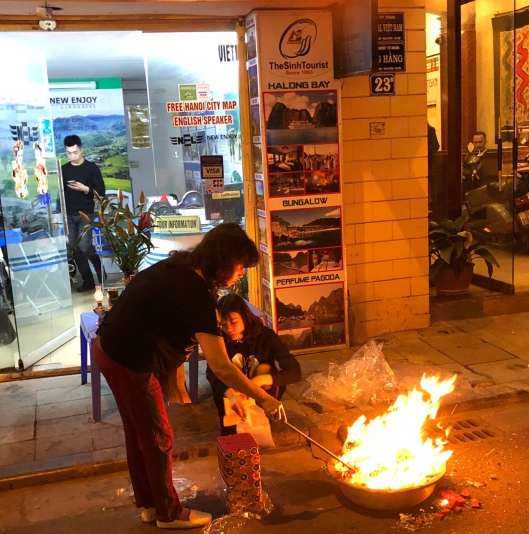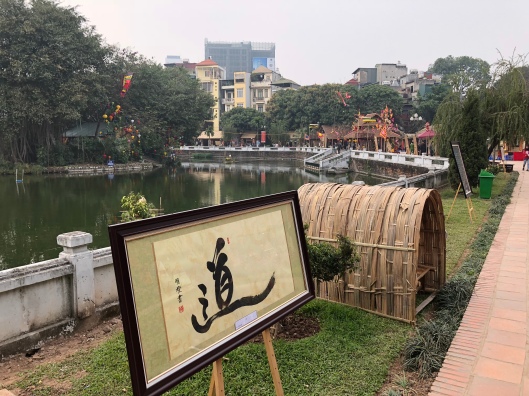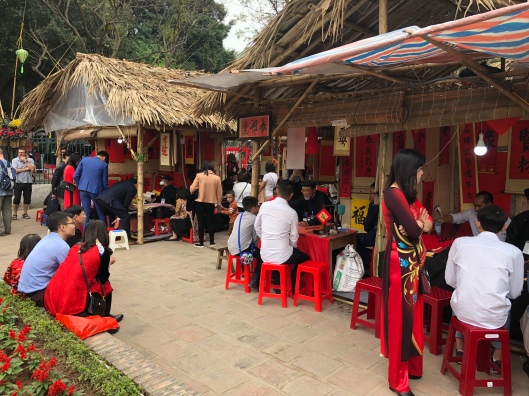Tags
Ancient Music Ensemble of Tonkin, Bamboo House Hanoi, Banh Chung, Buddhism, Food, Hanoi New Music Ensemble, Hanoi Old Quarter, Nom Calligraphy, Poetry, Temple of Literature, Tet Lunar New Year 2018, Tet Markets, Travel, Vietnam, Vu Nhat Tan

Craftsman Era sunset glows on “Good Health” our Nôm calligraphy scroll.
As we say a “good riddance” to the chaotic Year of the Boar and as the more hopeful Year of the Mouse approaches on Saturday January 25, 2020, my thoughts and dreams return easily to 2018. That was the year I experienced my first Vietnamese Tết Lunar New Year in Hà Nội, the Year of the Dog.
“Anh Jeff, we want to show you and chị Jan the real Việt Nam!” said our good friends.

Thủy taking Jan to a beautiful plum blossom farm outside of Hà Nội.
And the best way to load the elusive real Việt Nam on the hard drive of your mind? Experience the Tết Lunar New Year. Tết not only reviews our annual earthly life but also brings back the ancestors, connecting Heaven and Earth. It’s a holiday celebration that, by comparison, makes the Christmas season of the West appear minor.

The streets of the Old Quarter are transformed for the Tết Lunar New Year.
There are special foods. Unique natural decorations for every home. Flowers everywhere. Once a year Buddhist blessings. Trance ceremonies. Special Tết Lunar New Year markets. Old family members give red envelope money pockets to young family members (please, crisp American $2 bills if possible). Symbolic lucky colors to be worn. Neighbors are invited to your home based on their auspicious Lunar calendar astrological sign for that year. Nôm calligraphy, the almost extinct ancient calligraphy of Việt Nam, returns in special holiday markets. During the week of celebration, one day is for friends, another strictly for family. You can take a trip or should return to the village of your birth. The first act of the New Year, immediately after midnight strikes, should be making offerings to your ancestors and getting blessings, preferably at the Buddhist temple of your grandparents. The first message you receive must must must be lucky. You need a blessing card from a monk. You light a bonfire in front of your business, burning the memories of the past away, the smoke guiding your ancestors back to earth for a visit. Multiply that by millions of people as, collectively, all the departed family members of the entire country return for the night. Wander the back alley streets of Hà Nội for hours after midnight.
I could finally understand why my friends believe in ghosts.

One the countless street business bonfires.
Our oldest friend in Việt Nam is composer Vũ Nhật Tân. Vũ is his family name. On our numerous trips from the airport into Hà Nội, we kept noticing exit road signs for “Nhật Tân.” And sure enough, Nhật Tân is his namesake, a flower village on the banks of the Red River near Hà Nội that his parents love. They decided to name their son after the village of their dreams. Jan and I were invited to spend a fantastic day in Nhật Tân with Nhật Tân, along with friends Phạm Trường Sơn and Tràn Thư Thủy, exploring the vast nurseries that grow the flowers, the Tết kumquat and plum blossom trees, the Buddha hands, the pomelo and bananas and vegetables that sustain life in the city.

Jan in the miles and miles of nurseries of Nhật Tân with Nhật Tân.

Kumquat trees are an essential decoration for every home.

Plum blossom trees, the Christmas tree of Tết.

A cyclo delivery into town…..

….for the Tết Market in the Old Quarter of Hà Nội!
Similar to specialty Christmas Markets in the West, the Old Quarter of Hà Nội sprouts Tết Markets in its always beguiling urban landscape. If you need an old opium pipe or ceramic pottery from the Ly Dynasty, beautiful flowers, and then some more flowers, want to see teachers or parents with their students or children dressed up in traditional áo dài silks or, most importantly, select a Hoa Đào plum blossom branch for your home (like finding the perfect Christmas tree), then the Old Quarter is just the place.
Nowhere can one better experience the elegant chaos of our second home town of Hà Nội than wandering the Old Quarter streets during the Tết Marketplace. Jan and I were guided through this charming and ancient labyrinth of streets by our friends Vũ Nhật Tân and Đàm Quang Minh.

Yellow pillars mark the entrance to an Old Quarter Tết Market.

Teacher with her young students in traditional silk ào dài.

Jan smiling amidst the elegant chaos of the Old Quarter at Tết.

Đàm Quang Minh shopping for genuine antiques.

Lucky door and wall hangings for the home.

Need an antique opium pipe?
All this shopping makes me hungry!
In the United States we traditionally roast a turkey for Thanksgiving. In Việt Nam you communally boil bánh chưng, a mixture of glutinous rice, mung beans and pork belly wrapped into heavy packages using the mammoth mung bean leaves, tied into a package present with straw (they are square in the north of the country and tend to be round in the south).
For our necessary first training lesson, we were picked up early in the morning and taken without discussion to a district a bit out of town, towards the Bamboo House, a community location where our friends in the Ancient Ensemble of Tonkin rehearse. We walked down a narrow alley and were dropped off, to our surprise, at the home of Xuân Hoạch, one of the National Treasures of Vietnamese music, the Pete Seeger of Việt Nam. After Jan’s first lessons as a beginner, we would then go to the Bamboo House for a communal construction of bánh chưng on an epic scale.

Congratulations for Jan’s first bánh chưng!

A busy day of making bánh chưng at the Bamboo House.

Jan receiving more cooking tips.

A very big accomplishment with happy friends!

Hundreds of bánh chưng packages will steam for hours all night.
After a hand crushing morning making enough bánh chưng for the whole neighborhood, Jan and I went home quite tired. We struggled once again facing the endless traffic density of a major holiday and were truly fatigued. But when later we tried to say “No, we’re really tired and don’t think we’ll come back for the evening gathering,” we received a communal “Oh no, you MUST come!” from all our friends.
Best advice ever!
We didn’t realize it when we were tired after the strenuous morning, but we were now part of a Vietnamese village. The night the bánh chưng steams for the village, every neighbor drops in because the keepers of the flame of that enormous bánh chưng pot you see above are not allowed to fall asleep. It’s the responsibility of the entire village to come together, tell stories for the young children, visit, drink tea and rice wine, sing songs, and cook for and absolutely keep those bánh chưng flame keepers propped up all night – and it’s still not Tết yet!

Neighbors and their children arriving for the bánh chưng night.

The huge pot boils the bánh chưng for hours with a wood fire.

Jan and I becoming true Hanoians at the Bamboo House.

Yummy grilled pork belly for all!

The bánh chưng flame keepers keep watch over the fire logs.
We returned to our French Quarter apartment around midnight, drunk on rice wine and full of juicy pork belly, sweet potatoes, rice and tea, but there was still much more to come. The next morning, we visited the Harvard University of Hà Nội, the Temple of Literature, an easy and interesting walk from our apartment. The Temple of Literature is smack dab in the middle of Hà Nội and for the Tết Lunar New Year everyone assured us we should make a visit. We then went across the street to a seasonal Nôm calligraphy market, as charming an experience as we’ve ever had.

The always inspiring Temple of Literature.

The first inner courtyard.

Tranquil ponds, flower arrangements and Buddhist flags.

Across the street the Nôm Market beckoned.

Lucky red flowers and a kumquat tree with the statue of a scholar.
As Jan and I crossed the street to the Nôm Market, our curiosity was rewarded with an expansive redevelopment project of a neglected small pond. Around the entire circumference of this renovation was a pond brought back to civic life, with stalls of various kinds for silks, calligraphy scrolls, flags and pennants flowing in the spring wind, carved fruits, an inspiring stroll in a country that is rediscovering its cultural identity.

A weeping willow frames the circumference of the Nôm Market.

Vietnamese silks lightly bend in the breeze.

Leisurely browsing the stalls.

Various calligraphy works surround the Nôm Market pond.

Nôm Scholars ready to compose scrolls.
Nôm calligraphy is an endangered linguistic heritage. Developed during the one thousand year Chinese occupation of Việt Nam, Nôm script coexisted during the 19th century French colonization with Quốc Ngữ, the Romanized alphabet developed by a French Jesuit priest from Avignon, Alexandre du Rhodes. Working for the Portuguese, in 1651 he published the Dictionarum Annamiticum Lusitanum et Latinum a trilingual dictionary in Vietnamese-Portuguese-Latin. The French insisted on using the Quốc Ngữ script for their educational initiatives to train Vietnamese to work for them. Gradually over time the Quốc Ngữ became used by the entire country, to the point that when the Communists are victorious in 1954 over the French, they codify the Quốc Ngữ script as the official language of the country. This was an obvious call mid way through the 20th century, a common sense point of view. But the Nôm script never vanished, as every Buddhist temple to this day has Nôm inscriptions and there is an endowment of profound poetry and literature.
I was once walking by a Buddhist temple with Nôm inscriptions with a few Japanese friends in Huế. Because of the linguistic similarity found throughout East Asia with Chinese calligraphy, my Japanese friends were easily able to read the Nôm inscriptions, something out of reach for our Vietnamese hosts. “My word,” softly murmured my Japanese friend. “They have so much of their own history out of reach, lost. So difficult to reproduce this knowledge, scholarship must be kept alive.”
Currently there are about two hundred and fifty scholars who read and write Nôm. But there is an encouraging curiosity about the loss of this ancestral language, and this revival has animated my desire to write this post. Because at the various Nôm Markets around the country, it has become the “in” thing to have an old scholar compose a New Year’s greeting on a scroll for your grandparents, parents and friends.

A testament to Nôm as a young woman has a scroll written for her grandparents.

Lucky red colors are everywhere at the Nôm Market.

An elder scholar considers his Nôm message for our scroll.

Our friend Minh Nhgĩa, happy she translated our wishes.

The ink must dry after composition as a young boy looks on.

Sunset light shines each afternoon on our 2018 Nôm scroll in our Pasadena home.
As I let my memory float back to 2018 and our first experience of the Tết Lunar New Year, one moment speaks with special happiness. As Jan and I were walking back to our French Quarter apartment from the Tết Marketplace in the Old Quarter, I was carrying our hoa đào, or plum blossom branch, in my hand. As we walked amidst the perfect Tết weather – a dizzling light mist is required for the season to feel perfect in Hà Nội – countless people smiled at us with pride and happiness, wishing us as Americans a very Happy New Year. One man came up to us and said he’d never seen foreigners carry a hoa đào before!
Perhaps nothing is impossible. I grew up knowing Tết as only a massive military offensive in 1968, one hell of a year to be a teenager in the United States. An even worse year to be a teenager in Việt Nam, as my many Vietnamese friends can testify. But day by day, rehearsal by rehearsal with my friends in the Hà Nội New Music Ensemble, every day spent studying their beautiful but oh so difficult language, learning and learning about their world and history, together we demonstrate that nothing is impossible. That out of chaos eventually comes peace.
There is a famous old Vietnamese proverb about peace that goes something like this: “When the Dragon touches the Clouds, Peace is at hand.”

Walking in the Old Quarter with our hoa đào plum blossom branch.
Nothing is impossible. The next time I get to a Nôm Marketplace this old proverb would be just wonderful for our next Nôm scroll!
Happy New Year of the Mouse! Chúc mừng năm mới!
Best, best, best,
Jeff
